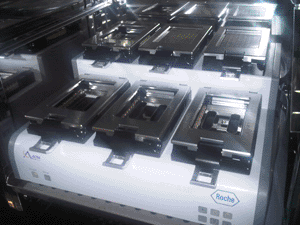First Human Kinome Screen Performed on High-throughput Cell Analyzer
By LabMedica International staff writers
Posted on 08 Aug 2011
A high-throughput cell analysis system has been adapted to perform a human kinome screen based on small interfering RNA (siRNA) transfections.Posted on 08 Aug 2011
The kinome of an organism is the set of protein kinases in its genome. Kinases are enzymes that catalyze phosphorylation reactions (of amino acids) and fall into several groups and families, e.g., those that phosphorylate the amino acids serine and threonine, those that phosphorylate tyrosine, and some that can phosphorylate both, such as the MAP2K and GSK families. As kinases are a major drug target and a major control point in cell behavior, the kinome has also been the target of large-scale functional genomics with siRNA screens and of drug discovery efforts, especially in cancer therapeutics.

Image: The xCELLigence RTCA MP Instrument (Photo courtesy of Roche).
In the current study investigators at the German Cancer Research Center (Heidelberg; www.dkfz.de) used the Roche (Nutley, NJ, USA) xCELLigence MP Instrument to perform a whole kinome screen using a human siRNA library that targeted 779 kinases and 80 cell cycle genes The xCELLigence system analyzed cell proliferation in real time, by monitoring the dynamics of the cellular responses after high-throughput gene knockdown. The details of the study were published in the July 13, 2011, online edition of the journal PLoS ONE.
Roche´s xCELLigence System for real-time cell analysis measures impedance-based signals both in label-free cellular analysis and in cell invasion/migration assays. The instrument is powered by proprietary software and it employs 96-well E-plates to measure electronic cell impedance using sensor electrodes. Computer-controlled signal generation, automatic frequency scanning, and a measurement rate of 12.9 milliseconds per 96-well plate, enable high-speed, precise detection of changes in cell behavior.
“We have carried out a human kinome siRNA screen using xCELLigence with electrical impedance as output. This screen has confirmed previously identified inhibitor genes, as well as activators of cell proliferation. Our data establish the technology of the xCELLigence system as a novel tool amenable for high-throughput screening, opening new avenues in the dynamic cellular analysis of phenotypes induced by siRNA and other perturbations,” said contributing author Dr. Stefan Wiemann, head of the division of molecular genome analysis at the German Cancer Research Center.
Related Links:
German Cancer Research Center
Roche













